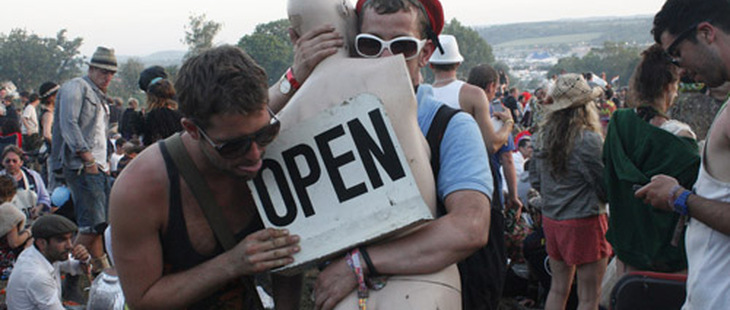
 (All photos by Zoe Cormier)
(All photos by Zoe Cormier)
Imagine you haven’t slept more than two hours a night for three days because towering soundsystems in every direction send thundering bass lines through the ground towards your sleeping bag. You can see your breath, because in this part of the world, the temperature drops to the dew point at night in the height of summer. You are in a tent. The insides of the polyurethane single sheet are dripping onto your dirty face.
Your face is muddy and your hair grimy. The nearest toilet consists of a metal cube, ten metres long, with a row of seats floating above a swirling Sargasso Sea. Showers boast hour-long line-ups. Sleep is a laughable ambition.
On every side of your tent, sprawling several hundred metres towards the horizon, are tents. And tents. And tents. All filled with similarly exhausted people, who have opted to spurn snooze for whisky and loud, confused conversation.
Your phone is dead. Your friends are nowhere to be seen. The noise is getting louder. Suddenly you realize one of your rubber boots is missing—presumably lost amid the rivers of mud meandering through the area.
And you never, ever, want to go home.
You didn’t just see your favourite band play to a swooning crowd 80,000 strong—you also watched as massive sheets of biodegradable bubble wrap was swaddled over a hill for people to slide around on, lubricated in soap and oil. Packs of men dressed as old ladies, croaking like Monty Python-style crones, offered you scones and smacked your bottom reproachfully. You found yourself wandering through replica shanty towns—featuring a giant concrete tower block with a subway car smashed into the side—when moments before you had been plodding through a grassy field surrounded by blacksmiths and teepees. You pedalled a giant hand-made steampunk gilded iron fountain to pour yourself a gin and tonic. In the middle of the night you found yourself singing “Gangster’s Paradise” inside a thatched-roofed, wooden benched speakeasy dug out of the earth—complete with grand piano and mead. You seriously considered spending $40 on a glitter gun.
Welcome to the strange experience of the English music festival: a five-day endurance test of rain, music, chemicals and costumes. Every summer the Isles find themselves hosting close to 500 outdoor music festivals—ranging from small folk gatherings with a few hundred guests, to the heaving mass of Glastonbury, teeming with more than 150,000 revellers (and several ten thousand more staff). The tickets come in at around 180—add to that the amount spent on travel, food and booze and it’s a hefty price tag to be cold, hung-over and sleepless. But even when a fest is a mud bath—2007’s Glastonbury being one of the worst on record, campsites transformed overnight into rivers—the next year still sells out as quickly as usual.
Faced with clouds, cramped conditions and the most horrid, overflowing toilets a Torontonian could never imagine, people find themselves behaving in the most unusual ways. No matter what is asked, they will share anything with a complete stranger: water, food, blankets, tent space, toilet paper, toothbrushes. Strangers with signs bearing “Free Hugs” are taken up on their offer. Shivering and unwisely clad men in tutus will be cuddled aside random fires by random strangers. Bras will be shared. Its as if one can witness the Blitz spirit return to England—a country where remember war rationing persisted into the 1950s—to a techno soundtrack.
Of course, the experience wouldn’t be so attractive if it weren’t for the music: the biggest acts in the world including Beyonce, Radiohead, U2, Jay-Z, Bjrk and Paul Simon headline. But the acts at most festivals, to be fair, are irrelevant to the popularity of the event: big events like Glasto will sell out within hours (or even minutes) long before the lineup is announced. Glastonbury’s after-hours art installation areas, including Shangri La, Block 9 and Arcadia, are mini-festivals in themselves.
 Glastonbury
Glastonbury
What truly makes the English festival experience distinctive lies not just in the music (Denmark’s mammoth Roskilde boasts an equally packed roster) or even the artistic installations (California’s Burningman is no less if not more impressive): it is the behaviour of the crowd itself that seems to be wholly distinctive. British people, simply put, like to make sublimely asinine spectacles of themselves. Monty Python was born here for a reason.
Nowhere might one observe this most English of propensities in its full glory than at the Secret Garden Party, a small festival held on private country grounds, dedicated to art, finery, and becoming your own main attraction. In the centre of the grounds: the Collisilliyum: a giant mud wrestling pit surrounded by stadium-seating stacks of haybales. (Most of the contestants are in fact male—it’s not the macho frat house atmosphere you might expect.) Everywhere on site, men wear ball gowns, people sport homemade robot costumes, and pantomime jousting contests take place and girls dressed as squirrels jump headfirst into the lake. Hills are clad in biodegradable bubble wrap for guilt-free slides, and used as “suicide sport” racing tracks for pimped out wheelchairs.

The stereotype of pallid, uptight, fusty, emotionally constipated people just doesn’t chime with the images of men in sparkly dresses careening down hills on bathtubs trimmed with roller skates. Perhaps what makes the spectacle so amusing is the fact that it is so counter-intuitive.
It is undeniable that a great part of the answer to this puzzle of a juxtaposition comes right down to the unadulterated fact that English people like to get very, very trashed. Any Canadian who has spent any time in England will be able to tell you that the English propensity to drink to the point of incontinence is impressive. It’s part of the culture—prohibition could never have taken root in Britain in the 1930s as was achieved in Presbyterian North America. Remember: our side of the Atlantic found itself populated by Puritans. Toronto became The Good for a reason.
The ability to bring your own alcohol and consume it at will is a marked feature of any English festival: once guests have passed the gates, security is indifferent to open vodka bottles openly carried about. It’s a free for all.
Of course, it’s more than alcohol: Heavy drugs are rampant throughout England, and nowhere more than at festivals. The epicentre for smoking, dropping and snorting is Glastonbury’s Stone Circle, which daily descends into what can only be described as the festival’s drug stock market: buyers and peddlers come to swap wares. From the thousands of traders one can hear prices negotiated through continual cries and replies. “Hash truffles for sale, one pound each or seven for a fiver!” “Is anyone looking for 2-CB?” “I’m only looking for free-base speed!”
I have seen and heard many eye-opening things at the Stone Circle, but one exchange sticks out in my mind: One stranger to another: “Have you been doing ketamine all night?” The reply: “Oh god I hope so.”

But drugs aside, these gatherings exist, grow and persist for ultimately, the music. The hippies thought music could bring us together and change the world—and here, at least, that belief can live on. Roughing it in abominably noisy fields strangely seems to bring out the best in people. The vibe (for want of a better word) is unmatched—people come back year after year and slog it through for good reason. One need only see 80,000 people gathered in front of one stage, all maneuvering with courtesy around each other, to witness the wisdom of crowds.
Would such congregations ever take place on the same size and scale in Canada? SARSstock may have been huge, but a diverse celebration of art and creativity it was not. What makes Britain so different? It’s undeniable that the drugs have a lot to do with the British approach—but is there more to it than that? Could music festivals take place in Canada, or even the U.S., on the same scale and level of intensity? Fred Fellowes, founder of the Secret Garden Party, is bringing his brand of party to the U.S. for the first time this summer with Escape2NY on Long Island next weekend. “It’s going to be a challenge because they don’t have any festivals quite like this—we hope this works.”

Could the British model take hold on our side of the world? In 1996 when I was 14, six hours of footage from Glastonbury put together by Avi Lewis (remember it?) inspired me to swear that I would see the festival for myself before the age of 25. I first made the pilgrimage when I was 20 and was transformed by the experience. It was as if I had forgotten how much I loved music. Toronto was bursting with gigs, but a festival of this nature seemed unlike anything I could experience at home. My father, a promoter who had also thrown many festivals of his own, said that Toronto audiences were frequently perceived as being “too cool for school”—slow to rouse and difficult to excite.
In the years since, Ontario has seen a proliferation of rural music parties, including Om, Harvest, Boreal and Shambala. Could they grow bigger? Of course part of the difference is simply spatial: England is tiny, with a population twice the size of Canada’s, and rail networks that allow you to get from London to Glastonbury in under two hours. Even if the distances Canadians faced were smaller, would they embrace the music with the same spirit? Given the chemical fuelled and liver compromising nature of the affair, would they even want to?
But if Canada can produce some of the most fantastically exuberant and experimental music in recent years—a recent Arcade Fire gig in Hyde Park (a stone’s throw from Buckingham Palace) drew more than 150,000 people—could we not create festivities to match those in colour and diversity? We certainly are no strangers to the sideshow acts that complete the English mode of celebration: Cirque de Soleil brought contortionist artistry into the mainstream. With summer weather far more amenable to outdoor events, and crowds of kids already thronging to Cherry Beach every summer, could Toronto possess something without realising it: a ready-made audience?














